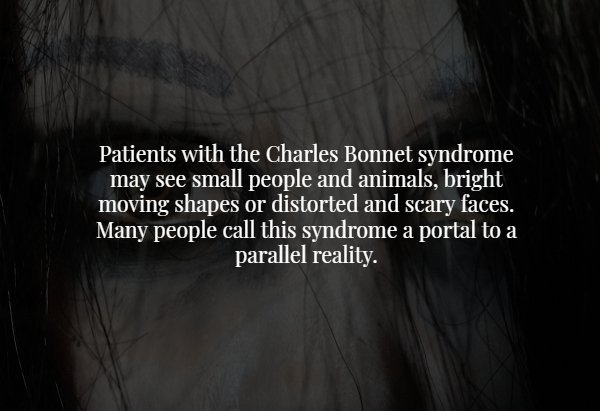Patients with the charles bonnet syndrome may see small people and animals bright moving shapes or distorted and scary faces many people call this syndrome a portal to a parallel reality

Patients with Charles Bonnet Syndrome: A Gateway to Parallel Reality

Have you ever wondered what it would be like to step into a parallel reality? A world where small people and animals roam freely, bright moving shapes fill the air, and distorted and scary faces send shivers down your spine? For individuals experiencing Charles Bonnet Syndrome, this is their reality.
Charles Bonnet Syndrome (CBS) is a fascinating yet perplexing condition that affects individuals with visual impairments. These individuals, despite having significant visual loss, experience vivid and complex visual hallucinations. It is as if their brains, deprived of external visual stimulation, create a vibrant and alternative reality inside their minds.

People living with CBS often describe seeing a wide range of hallucinations. These can include seeing tiny people or animals traversing across their visual field, mysterious and brightly colored moving objects, or even encountering distorted and frightening faces that seem to follow their every move.
Although it may sound like the plot of a science fiction novel, CBS is a real condition that affects many individuals. The phenomenon was first described by Charles Bonnet, a Swiss philosopher, and naturalist, in the 18th century. He noticed that his visually impaired grandfather experienced vivid hallucinations, and his observations led to the discovery of this unique syndrome.
Scientifically, the exact cause of CBS remains unclear. However, researchers believe that the brain’s response to a lack of visual input plays a significant role. When the brain no longer receives sufficient external visual stimuli, it compensates by generating its own images, resulting in hallucinations. These hallucinations can often be incredibly detailed, complex, and colorful, providing a fascinating insight into the inner workings of our minds.
Despite their mystical appearance, hallucinations experienced by individuals with CBS are not indicative of mental illness or dementia. It is crucial to understand that these visions are a result of the brain’s attempt to fill in the gaps left by impaired vision. Many individuals with CBS are aware that their hallucinations are not real, which can often lead to feelings of confusion and isolation. Raising awareness about this condition is essential to ensure those affected receive the support and understanding they need.
While CBS may be distressing for some individuals, others view it as a unique and sometimes even entertaining experience. Some people find solace in their hallucinations, as they offer a respite from the monotony of their visual impairment. For these individuals, CBS becomes like a window into a magical parallel reality, a doorway to a world brimming with imagination and creativity.
In conclusion, Charles Bonnet Syndrome serves as a fascinating reminder of the intricate capabilities of our minds. These individuals who possess impaired vision are provided the opportunity to peer into alternative realities, filled with an array of small people, animals, and captivating shapes. As we delve deeper into understanding this syndrome, we can provide much-needed support to those experiencing CBS, ensuring they are not left feeling isolated or misunderstood.
Source: Wikipedia
Share
Related Posts
Quick Links
Legal Stuff

